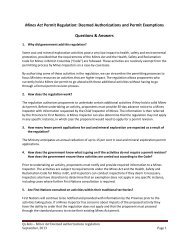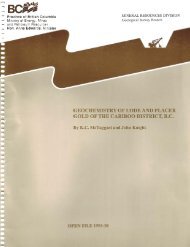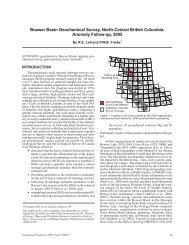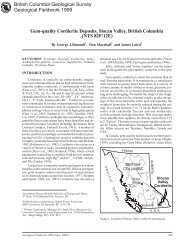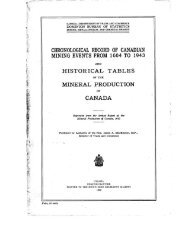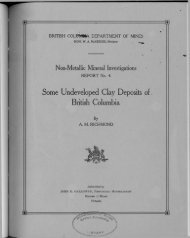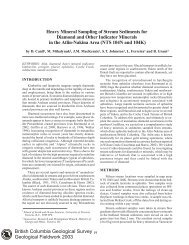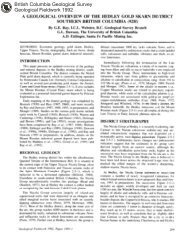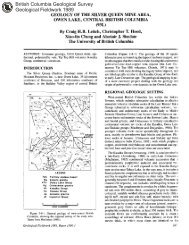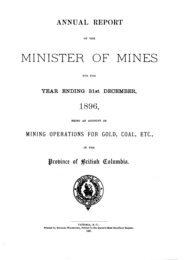Create successful ePaper yourself
Turn your PDF publications into a flip-book with our unique Google optimized e-Paper software.
BRITISH COLUMBIA DEPARTMENT OF MINES<br />
HON. E. C. CARSON, Minisfer JOHN F. WALKER, Deputy Minister .<br />
BULLETIN NO. 20-PART 11.<br />
<strong>LODE</strong>-<strong>GOIJD</strong> <strong>DEPOSITS</strong><br />
South-eastern British Columbia<br />
by<br />
W. H. MATHEWS
PREFACE.<br />
Bulletin 20, designed for the use of those interested in the discovery of goldbearing<br />
lode deposits, is being published as a series of separate parts. Part I. is to<br />
contain information about lode-gold production in British Columbia as a whole, and<br />
will be accompanied by a map on which the generalized geology of the Province is represented.<br />
The approximate total production of each lode-gold mining centre, exclusive<br />
of by-product gold, is also indicated on the map. Each of the other parts deals with a<br />
, major subdivision of the Province, giving information about the geology, gold-bearing<br />
lode deposits, and lode-gold production of areas within the particular subdivision. In<br />
all, seven parts are proposed:-<br />
PART I.-General re Lode-gold Production in British Columbia.<br />
PART 11.-South-eastern Britis:h Columbia. ’<br />
PART 111.-Central Southern British Columbia.<br />
PART 1V.-South-western British Columbia, exclusive of Vancouver Island,<br />
PART V.-Vancouver Island.<br />
PART VI.-North-eastern<br />
Creek Areas.<br />
British Columbia, including the Cariboo and Hobson<br />
PART VI1.-North-western British Columbia.<br />
By kind permission of Professor H. C. Gunning, Department of Geology, University<br />
of British Columbia, his compilation of the geology of British Columbia has<br />
been follo-wed in the generalized geology represented on the map accompanying Part I.<br />
Professor Gunning’s map was published in “The Miner,” Vancouver, B.C., June-July,<br />
1943, and in “The Northern Miner,” Toronto, Ont., December 16th, 1943.
SOUTH-EASTERN BRITISH COLUMBIA.<br />
INTRODUCTION.<br />
South-eastern British Columbia for the purpose of this publication consists of<br />
the whole of Golden, Revelstoke, Lardeau, Slocan, Ainsworth, Fort Steele, and Nelson<br />
Mining Divisions, and of Trail Creek Mining Division except for a 2;mall area east of<br />
Paulson which is treated in Part 111.-Central Southern British Columbia.<br />
In the period from 1900 to 1943, inclusive, South-eastern British Columbia is<br />
credited .with a total recovery of 3,860,000 02. of gold from lode deposits out of a total<br />
of 11,323,000 oz. for the Province. Trail Creek Mining Division produced 2,603,900<br />
oz., of which more than 98 per cent. came from mines in the Rossland camp, which also<br />
produced important quantities of silver and copper. The adjoining Nelson Mining<br />
Division is credited with a recovery of 1,220,000 02. of gold, more th:m 99 per cent. of<br />
which was from ore valued primarily for its gold content.<br />
Production of gold from lode deposits of other mining divisions in South-eastern<br />
British Columbia amounted to less than 38,000 oz., of which slightly more than half<br />
came from Lardeau Mining Division. Deposits valued principally for 'their gold content<br />
have been mined in Lardeau and Slocan Mining Divisions, hut a considerable part<br />
of the lode gold from these mining divisions and most of the lode gold from the.Golden<br />
and Fort Steele Mining Divisions was recovered<br />
silver-lead-zinc ores.<br />
as a by-product in the mining of<br />
The following notes are based on studies of various publications, principall~ those<br />
of the British Columbia Department of Mines and of the Geological Survey of Canada.<br />
Some general information for each mining division is given under the name of the<br />
division. For several mining'divisions notes regarding lode-gold (camps within the<br />
division follow the general information. The figures after the name of a camp indicate<br />
the latitude and longitude of the south-eastern corner of the one-degree quadrilateral,<br />
and the letters indicate the quadrant of the quadrilateral in which the camp lies. At<br />
the end of each section a list of references is given. Those interested in a particular<br />
area would be well advised to consult thk Annual Reports of the Min:ister of Mines for<br />
information about properties, and to study the maps and reports dealing with the area.<br />
TRAIL CREEK. MINING DIVISION.<br />
1NTR.ODUCTION.<br />
The mines centring in the city of Rossland have produced almost 99 per cent. of<br />
the total gold production of the Trail Creek Mining Division. The Rossland camp,<br />
from an area about 1 mile long and l/z mile wide, has produced more than 2,900,000 02.<br />
of gold and substantial quantities of silver and copper, much more<br />
produced by any other camp in the Province.<br />
gold than has been<br />
The other camps of the Trail Creek Mining Division-O.K. Mountain, 1% miles<br />
south-west of Rossland; the Velvet-Portland, 6 miles south-west of Rossland; and near<br />
Paulson, 12 miles north-west of Rossland-were all discovered in the '90's and have<br />
yielded about 50,000 oz. of gold since that time<br />
Gold-bearing veins east of Paulson in the Trail Creek Mining Division and deposits<br />
in the Burnt Basin camp, west of Paulson, in the Greenwood Mining Division, are the<br />
subject of a note in Part 111.-Central Southern British Columbia.<br />
7
ROSSLAND CAMP (49" 117" S.W.).<br />
History.-The discovery of the lead-silver'ores of A'insworth on Kootenay Lake in<br />
1883 and of the silver-copper lode of the Silver King near Nelson in 1886 attracted<br />
prospectors to the West Kootenay area and by the early '90's the gold lodes of the<br />
.Rossland camp had been discovered and staked. It was not until the completion of rail<br />
communications with Trail and Spokane in 1895 and 1896, however, that major operations<br />
at Rossland commenced. By 1902 that camp attained its peak production of<br />
126,000 oz. of gold, 373,000 oz. of silver, and 11,667 Ib. of copper from about 330,000<br />
tons of ore. From that time till 1916 the annual production of gold remained between<br />
94,000 and 145,000 oz. After 1917, shortages in supplies and then decline in ore<br />
reserves brought about a very marked drop in annual output, which by 1923 had fallen<br />
to less than 7,000 oz. of gold. All but a small part of the ore was smelted directly,<br />
most of it at Trail, although for a few years some ore was smelted at Northport, Washington.<br />
In 1924 the Consolidated Mining and Smelting Company, which by that time<br />
had assumed control of all of the larger mines, attempted concentrating the ores before<br />
smelting, but the experiment was not continued. Mining ore at a reduced rate and<br />
exploration continued till about 1928. In the early '30's the Consolidated Mining and<br />
Smelting Company leased parts of its holdings to individuals or groups of miners and<br />
this move, coupled with the rise in the price of gold, led to an increase in production<br />
to over 25,000 oz. of gold in 1934, obtained from ore in surface exposures, in the upper<br />
workings of the old mines, and in the old dumps. This ore was smelted in one of the<br />
lead-furnaces at Trail, some of it after successful concentration in the company's mill.<br />
In the late '30's all the lead-furnaces were required for lead-smelting; the Rossland<br />
production had therefore<br />
oz. of gold annually.<br />
to be reduced, and from 1936 to 1939 averaged about 9,000<br />
Economic Geology.-The oldest rocks of the Rossland camp are sediments and<br />
pyroclastics of Palieozoic age. These have been extensively intruded by sills of dark<br />
grey to greenish-black augite porphyry, by granodiorite with offshoots of diorite<br />
porphyry, and by an irregular mass of monzonite. The gold ores, which contain<br />
subordinate values in. copper and silver, occur in replacement veins along fissures or<br />
shears, cutting the intrusive rocks and having a general easterly'strike and a high<br />
northward dip. Smaller amounts of gold ore occur in fractures meeting these veins<br />
at high angles. The main veins are, in general, confined to the brittle competent<br />
intrusive rocks. Shears in the incompetent sediments and schistose rocks were apparently<br />
unfavourable for the deposition of ores. , The veins generally follow. the contacts<br />
between the augite porphyry and any one of the other intrusive rocks. Some of the<br />
veins are very persistent, extending for as much as 4,000 feet along the strike and<br />
mining has been carried on down their dips to more than 1,500 feet below the surface.<br />
They are, however, commonly offset by faults, some of which are occupied by later<br />
lamprophyre dykes. The vein-widths vary from a few inches to a maximum of 130<br />
feet. Within the veins there are ore-shoots from 50 to over 500 feet long, from a few<br />
feet to 130 feet wide, and as much as 750 feet in pitch length. These shoots pitch<br />
steeply, either to the east or west. Some are developed along the foot-walls of crosscutting<br />
dykes, others along the intersections with mineralized cross-fractures. Some<br />
wall-rocks, notably the more sodic diorite, were apparently more favourable for replacement<br />
than others, and in these the ore-bodies are wider and richer than elsewhere.<br />
Mineralization consists of pyrrhotite and chalcopyrite with smaller amounts of pyrite,<br />
arsenopyrite, and molybdenite in a gangue of altered wall-rock and quartz. In the<br />
southern part of the camp galena and sphalerite are present in significant amounts.<br />
In places the ores may be almost solid sulphide, elsewhere rich gold ore may be nearly<br />
barren of sulphides. Wall-rock alteration includes the development of aggregates and<br />
grains of quartz, together with biotite, hornblende, and, less commonly, pyroxene.<br />
Surface oxidation does not continue to depths<br />
major fissures.<br />
of more than a few feet, except along<br />
8
O.K. MOUNTAIN (49" 117" S.W.).<br />
The gold ores of 0.K. Mountain, 1% miles south-west of Rossland, occur in quartzfilled<br />
fractures cutting altered basic and andesitic volcanics overlyin:$ a body of serpentine.<br />
All the gold production has been from veins not more than 1,000 feet from<br />
the serpentine. The veins, which are up to 2 feet wide, strike easterly and dip at<br />
moderate to steep angles southward towards the serpentine. At the serpentine contact,<br />
however, they invariably die out. Ore-shoots consist of parts of the veins which<br />
are richer, but not necessarily wider, than elsewhere, and in some cases ore-shoots<br />
occur where veins and cross-fractures i.ntersect. The veins are composed of quartz<br />
with minor amounts of pyrite, chalcopyrite, and galena. Production to 1943 amounted<br />
to 30,000 02. of gold, mainly from the I.X.L. and Midnight mines, from<br />
than 8,000 tons of ore.<br />
a little more<br />
VELVET-PORTLAND (49" 117" S.W.).<br />
The gold ores of the Velvet-Portland mine, 6 miles south-west of Rossland, occur<br />
in northerly-trending replacement veins dipping steeply to the west and cutting altered<br />
volcanics. Ore-shoots occur at the intersections of the veins with crosscutting dykes<br />
or faults. Mineralization includes copper and iron sulphides, and .molybdenite in a<br />
gangue of'altered wall-rock and quartz. Production to<br />
02. of gold from about 58,000 tons of ore.<br />
1943 has amounted to 17,000<br />
MISCELLANEOUS.<br />
Outside of the above-mentioned camps, gold production from the Trail Creek Mining<br />
Division has been negligible. A few ounces of gold have been produced from the<br />
Mighty Midas property at Violin Lake, 6 miles south-east of Rossland, and a few ounces<br />
have been recovered as a by-product of copper and silver production from the MonntairL<br />
Chief mine near Renata on Arrow Lake.<br />
REFERENCES.<br />
DRYSDALE, C. W. (1915) : Geology and ore deposits<br />
Mem. 77.<br />
of Rossland-Ge'd. Surv., Canada,<br />
BRUCE, E. L. (1916) : Geology and ore deposits of Rossland-Ministor<br />
Ann. Rept., pp. 214-244.<br />
of Mines, B.C.,<br />
STEVENSON, J. S. (1935) : Rossland camp-Minister<br />
pp. E 4-E 11.<br />
of Mines, J?.C., Ann. Rept.,<br />
i - (1942) : Ore deposits as related to structural features; gold-quartz veins, OX.<br />
Mountain-Princeton University Press, pp. 246-247.<br />
~ICHMOND, A. M. (1932) :. Trail Creek Mining Division; lode-gold deposits of British<br />
Columbia-B.C. Dept. of Mines, Bull. 1, pp. 121-125.<br />
Annual Reports of the Minister of Mines, B.C.<br />
NELSON MINING DIVISION.<br />
History.-During the latter part of the last century placer gold was recovered from<br />
several streams in the Nelson Mining Division. In 1886 the Silver King mine, a silvercopper<br />
lode deposit situated a few miles south of Nelson, was staked. The construction<br />
of the Nelson and Fort Shepherd Railway in 1893 made the area more accessible, and<br />
when the boom in the near-by Rossland camp had subsided intensive prospecting for<br />
lode deposits was carried on. In the period from 1696 to the turn of the century most<br />
of the deposits which became the larger gold producers were discovered. From 1690 to<br />
1916 mining yielded a total of about 350,000 oz. of gold. At that time much of the gold<br />
was recovered by amalgamation, and difficulties were encountered once the oxidized ores<br />
of the upper parts of the veins were exhausted; a large number of the veins that were<br />
9<br />
I
again to prove profitable were then abandoned. During the First Great War many<br />
the mines were closed because of rising costs. For the following ten years there was<br />
of<br />
little gold-mining activity, except at a few properties from which siliceous ores, desired<br />
as flux, were shipped to the smelter at Trail at favourable treatment rates. Interest<br />
in lode-gold mining increased from 1926 onward and from 1932 to 1938 production<br />
grew steadily, reaching a total of 332,000 tons, yielding almost 125,000 oz. of gold in<br />
1938. Approaching exhaustion of some of the deposits brought a reduction of output<br />
in 1939 and the difficulties of operating under war conditions have reduced the output<br />
still further. A feature of the revival of lode-gold mining was a general improvement<br />
in milling, the mills being of larger average capacity than in the earlier period, having<br />
superior grinding equipment, and using cyanidation or cyanidation with flotation instead<br />
of cyanidation as an adjunct of amalgamation. In this revival Sheep Creek, Ymir, and<br />
Erie Creek again became important lode-gold camps, and production was begun at<br />
the Bayonne and Alpine properties in sections from which there had not previously<br />
been important production.<br />
Economic Geology.-In the Nelson Mining Division gold mineralization is more<br />
widespread than in any other part of the Kootenays. An area 10 to 20 miles wide,<br />
extending from the Kootenay River at Nelson southward for about 40 miles to<br />
the International Boundary, contains between 100 and 150 deposits from which gold<br />
has been produced. Virtually all this production has been from quartz veins of varying<br />
habits and relationships. Within the area, however, there are several clusters or concentrations<br />
of gold deposits, in each of which the gold deposits show certain similarities<br />
to one another. General descriptions of the deposits in these different clusters are<br />
given below. The Ymir and Sheep Creek camps have been the mast productive and<br />
are described first. Available information concerning some<br />
deposits is, in general, less complete.<br />
of the other camps and<br />
YMIR CAMP (49" 117" S.E.).<br />
The greater part of the gold production of the Ymir camp has been from quartz<br />
veins in a northerly-trending belt east of the Salmo River near the western contact of<br />
a part of the Nelson batholith. The rocks in which the veins occur are steeply dipping<br />
schistose sediments, having a general strike of a few degrees east of north, and cut by<br />
Sills of granodiorite, offshoots of the larger mass to the east. The veins occupy northwestward-dipping<br />
fault-fissures which strike from north 60" east to east diagonally<br />
across the sediments and sills. Faults striking from a few degrees east of north to<br />
north-east, generally.paralle1 to the schistosity, cut or terminate the veins, and may be<br />
occupied hy mineralized veins which so far have not been productive. Within the pro-<br />
ductive diagonal veins individual ore-shoots tend to follow the intersections of the vein<br />
fractures with sills. In addition the ore-zone, or zone of ore-shoots, pitches steeply to<br />
the east. Mineralization consists of galena, with which the gold is in many cases<br />
associated, pyrite, sphalerite, and in some cases pyrrhotite, in a gangue of quartz.<br />
TO 1943, veins of this type in the Ymir, Goodenough, Yankee GirL, Dundee, and Centre<br />
Star (Wesko) mines have yielded more than 250,000 oz. of gold from abcut 840,000 tons<br />
mined.<br />
REFERENCES.<br />
DRYSDALE, c. w. (19171 : Ymir mining camp-Geol. Surv., Canada, Mem. 94.<br />
COGKFIELD, W. E. (1936) : Lode-gold deposits of Ymir-Nelson area-Geol. Sum.,<br />
Canada, Mem. 191.<br />
WRIGHT, L. B., and MORRELL, L. G. (1938) : Ymir Yankee Girl gold mine-pans,<br />
A.I.M.E. T.P. 937.<br />
Annual Reports of the Minister of Mines, B.C.<br />
10<br />
~. ,
SHEEP CREEK CAMP (49" 117" S.E.).<br />
Gold production from the Sheep Creek camp has been almost exclusively from<br />
quartz veins cutting a dominantly quartzitic part of a succession of sedimentary rocks<br />
striking north-north-east across the upper part of Sheep Creek. A few miles to<br />
the south, west, and north-west, stocks or cupolas of the Nelson batholith, cutting<br />
the sediments, are exposed at the surface. The quartz veins occupy fault-fissures<br />
which strike north of east diagonally across the bedded rocks. In th.is camp the veins<br />
are vertical or dip steeply southward. .In general, ore is found in important quantity<br />
only where the veins cut brittle quartzites. Ore-shoots, therefor'e, tend to follow<br />
the intersections of the veins with particularly favourable beds. The productive parts<br />
of veins are found cutting dark quartizites, mapped as the Reno Sormation, and in<br />
the upper part of the Quartzite Range formation which consists of white quartzite.<br />
The veins, where mined, rarely exceed 5 feet in width and average slightly less than<br />
2 feet wide. In places they branch and .two sub-parallel fractures may then contain ore.<br />
Ore-shoots range up to several hundred feet in length. The veins have been productive<br />
within a comparatively restricted vertical range, between 5,000 and 6,000 feet above<br />
sea-level at the northern end of the camp and between 2,500 and 4,000 feet at the<br />
southern end. As in the Ymir camp, the veins are mineralized with :pyrite, pyrrhotite,<br />
galena, and sphalerite, but the average sulphide content is less. Gold is usually<br />
associated with the pyrite but, in general, gold values also accompany the sphalerite<br />
and galena. Chalcopyrite, bornite, and tungsten minerals are present in some oreshoots.<br />
Production to 1943 from these veins has been<br />
1,500,000 tons of 'ore.<br />
REFERENCES.<br />
678,220 oz. from slightly over<br />
WALKER, J. F. (1934) : Geology and mineral deposits of Salmo map-area-Geol. Surw.,<br />
Canada, Mem. 172.<br />
MCGUIRE, R. A. (1942) : Sheep Creek gold mining camp-C.I.M.M., Trans. Vol. XLV.,<br />
pp. 169-190.<br />
O'GRADY, B. T. (1932) : Lode-gold deposits of British Columbia; Sheep Creek gold<br />
camp-KC. Dept. of Mines, Bull. 1, pp. 105-108.<br />
Annual Reports of the Minister of Mines, B.C.<br />
NELSON AREA (49" 117" S.E.).<br />
Within a radius of 8 miles south and west of Nelson there are many gold-bearing<br />
veins. Most of this area is underlain by volcanic rocks, now altered to greenstones and<br />
chlorite schists, intruded, especially in the northern part, by a number of granitic<br />
tongues and satellites of the Nelson batholith. The gold occurs either in quartz-filled<br />
fissure veins with more or less clearly. defined walls or in shear-zones where the mineralization<br />
extends into the walls for some distance from the quartz veins. Veins<br />
occur both in the volcanics and in the granitic rocks. In the former they may cut<br />
across or conform with the planes of bedding or schistosity of the enclosing rocks.<br />
The attitudes of the veins vary widely. Even in a single vein th.e attitude is not<br />
constant, indeed, where it crosses a contact from one type of rock to another the strike<br />
and dip may change abruptly, as at the Athabasea mine where the vein passes from<br />
granite to chlorite schist. Many normal faults, some occupied by lamprophyre dykes,<br />
cut the veins and add difficulties to their development. The veins range in width from<br />
a few inches to almost 8 feet but are generally narrow. In general only the wider veins<br />
constitute ore but in some cases veins as narrow as 1 foot have been mined. In few<br />
cases has there been sufficient development and study to determine the structures<br />
localizing the ore-shoots. In addition to quartz and gold the minera!ization includes<br />
pyrite, galena, sphalerite, chalcopyrite, as well as rarer sulphantimonides and oxidized<br />
ore minerals. The gold production of the camp, mainly from the G?.anite-Poorman and<br />
Athabasea mines, has totalled over 75,000 oz. from 175,000 tons mined up to<br />
11<br />
1942.
This has been represented on the map accompanying Part I. by two symbols-one<br />
centring on Toad Mountain, the on other Hall Creek. ,' .<br />
REFERENCES.<br />
LEROY, 0. E. (1911) : Geology of Nelson map-area-Geol. Surv., Canada, Summ. Rept.,<br />
pp. 139-157.<br />
COCKFIELD, W. E. (193F) : Lode-gold deposits of Ymir-Nelson area-Geol. Surv.,<br />
Canada, Mem. 191.<br />
O'GRADY, B. T. (1932) : Lode-gold deposits of British Columbia; deposits in Rossland<br />
volcanics, Nelson batholith-B.C. Dept. of Mines, Bull. 1, pp. 95-98.<br />
Annual Reports of the Minister of Mines, B.C.<br />
DOMINION MOUNTAIN (49" 117" S.E.).<br />
Another group of properties occurs on Dominion Mountain, 7 miles north-west of<br />
Ymir, those of its western slope being accessible by way of Erie Creek and those of its<br />
eastern slope by way of Barrett Creek. All but one of these properties lie within a belt<br />
of volcanic rocks, now greenstones and green schists, containing minor amounts of<br />
intercalated sediments. Within 2 miles to the north-west and west of this area of<br />
volcanics is a large body of granitic rock, another part of the Nelson batholith,<br />
The most important gold-bearing quartz veins, those of the Second Relief and Porto<br />
Rico mines, strike north-easterly and dip north-westward at moderate to high angles.<br />
In both mines the main veins, for Considerable parts of their lengths, follow the walls<br />
of dykes-in the former a dyke of diorite porphyry and in the lattei. of lamprophyre.<br />
The influence of wall-rocks is important. Where the veins follow the dykes through<br />
brittle greenstones they are wider or richer than in less competent volcanics or<br />
the slates. The widths of the veins vary from a few inches to almost 15 feet, but<br />
where mined average about 2 feet. Almost the full length of the Second Relief vein,<br />
over 1,000 feet, has been mineable. Mineralization includes pyrite, pyrrhotite, chalcopyrite,<br />
and gold. Production from this area, mainly from the Second Relief mine, has<br />
exceeded 103,000 oz. of gold from slightly less than 250,000 tons of ore mined.<br />
REFERENCES.<br />
DRYSDALE, C. W. (1917) : Ymir mining campGeo1. Surv., Canada, Mem. 94.<br />
COCKFIELD, W. E. (1936) : Lode-gold deposits of Ymir-Nelson area-Geol.<br />
Canada, Mem. 191.<br />
Surv.,<br />
O'GRADY, B. T. (1932) : Deposits in Rossland volcanics, Nelson batholith; lode-gold<br />
deposits of British Columbia-B.C. Dept. of Mines, Bull. 1, pp. 95-102.<br />
Annual Reports of the Minister of Mines, B.C..<br />
KEYSTONE (MINERAL) MOUNTAIN (49" 117" S.E.).<br />
On Keystone (Mineral) Mountain, about 3 miles north of the town of Salmo,<br />
several gold-producing properties, notably the Arlington, Keystone, and Clubine-<br />
Comstock mines, are situated in the southward continuation of the belt of volcanics<br />
of the Nelson and Dominion Mountain areas. In this locality there is a considerable<br />
proportion of sediments associated with the volcanic rocks. A large granodiorite<br />
intrusive extends eastward from the eastern slopes of Keystone Mountain. The gold<br />
occurs in quartz veins occupying fissures or shears in the sediments and volcanics.<br />
The productive veins of this area have diverse strikes but all have low dips. The most<br />
important vein follows a granite sill, another productive vein follom the foot-wall of<br />
a lamprophyre dyke. Mineralization consists of quartz, pyrite, gold, some galena and<br />
sphalerite, and occasionally chalcopyrite. Production, mainly from the Arlington mine,<br />
has amounted to over 53,000 oz. of gold from 29,000 tons of ore mined. Most of this<br />
ore has been mined selectively and shipped to Trail to be smelted.<br />
12
REFERENCES.<br />
WALKER, J. F. (1934) : Geology and mineral deposits of Salmo map-wea-Geol. Surv.,<br />
Canada, Mem. 172.<br />
O'GRADY, B. T. (1932).: Deposits in Rossland volcanics, Nelson batholith; lode-gold<br />
deposits of British Columbia-B.C. Dept. of Mines, Bull. 1, pp. 95-102.<br />
Annual Reports of the Minister of Mines, B.C.<br />
BAYONNE AREA (49" 116" S.%'.).<br />
The gold deposits of the Bayonne area, which lies from 5 to 7 miles east of<br />
the Sheep Creek camp, occur within two granodiorite or quartz-diorite stocks. The gold<br />
occurs in quartz veins which have a north-easterly to easterly strike and high dips to<br />
the south. Vein-widths rarely exceed 3 feet. Mineralization consists of quartz with<br />
pyrite, galena and sphalerite. Lenses of almost pure galena occurring within<br />
the veins carry moderate values in silver but very little gold. Production, mainly from<br />
the Bayonne mine, has amounted to over 40,000 oz. of gold from abont 84,000 tons of<br />
ore mined.<br />
REFERENCES.<br />
RICE, H. M. A. (1941) : Nelson map-area, east half-Geol. Surv., Canada, Mem. 228.<br />
SARGENT, H. (1937) : Bayonne-Midge Creek area-Ministel<br />
pp. E 8-E 22.<br />
of Mines, B.C., Ann. Rept.,<br />
O'GRADY, B. T. (1932) : Deposits in Rossland volcanics, Nelson batholith; lode-gold<br />
deposits of British Columbia-B.C. Dept. of Mines, Bull. 1, pp. 9.5-102.<br />
Aniual Reports of the Minister of Mines, B.C.<br />
SITKUM CREEK AREA (49" 117' N.E.).<br />
At the head of Sitkum Creek, 13 miles north of Nelson, there are a number of gold<br />
prospects of which one, the Alpine, came into production within the last five years.<br />
Gold from this deposit occurs in a quartz vein striking east-north-east, dipping at low<br />
angles to the north and cutting granite of the Nelson batholith. ' The vein is lenticular,<br />
ranging in width up to at least 7 feet. Mineralization includes pyrite and a small<br />
amount of galena and sphalerite. Production has amounted to about<br />
from 20,000 tons of ore mined.<br />
REFERENCE.<br />
:lO,OOO oz. of gold<br />
MACONACHIE, R. J. (1938) : Alpine Gold Co., Ltd.-Minister of Mines, B.C., Ann. Rept.,<br />
pp. E 13-E 15.<br />
MISCELLANEOUS <strong>DEPOSITS</strong> (49' 117" S.E.).<br />
In recent years very minor amounts of gold ore have been shipped from properties<br />
in the western and southern parts of the Salmo area. Of those near the upper part<br />
of Beaver Creek and west of the Salmo River there is little information available.<br />
About 100 oz. of gold have been produced from the Rosebud Lake area, east of Salmo<br />
River, from quartz veins following sheam in schists, argillites, and limestones.<br />
Several thousand ounces of gold have been produced at the Durango (Howard)<br />
mine, 5 miles south-east of Ymir, from a northerly-striking replacement fissure-vein<br />
cutting quartzites and granite, and containing pyrrhotite, pyrite, sphalerite, galena, and<br />
quartz.<br />
A small amount of gold has been produced from granitic areas not treated elsewhere,<br />
notably from the area a few miles north-east of Ymir on Ymir (Creek. The gold<br />
in these deposits occurs in quartz veins of various attitudes mineralized with pyrite,<br />
pyrrhotite, galena, and sphalerite. Total production from these sources has amounted<br />
to about.9,OOO oz. from about 19,000 tons of ore mined. On the map accompanying<br />
Part.1. nearly all this production is included with the Ymir camp.<br />
13
REFERENCES.<br />
DRYSDALE, C. W. (1917) : Ymir mining camp-Geol. Surw., Canada, Mem. 94.<br />
COCKFIELD, W. E. (1936) : Lode-gold deposits of Ymir-Nelson area-Geol.<br />
Canada, Mem. 191.<br />
Surw.,<br />
O'GRADY, B. T. (1932) : Deposits in Rossland volcanics, Nelsdn batholith; lode-gold<br />
deposits of British Columbia.-B.C. Dept. of Mines, Bull..l, pp. 95-102.<br />
MACONACHIE, R. J. (1938) : Rosebud Lake area-Minister of Mines, KC., Ann. Rept.,<br />
uu. E 17-E 22. "<br />
WALKER, J. F. (1934) : Geology and mineral deposits of Salmo map-area-Geol.<br />
Canada, Mem. 172.<br />
Annual Reports of the Minister of Mines, B.C.<br />
Sum,<br />
CONTACT METAMORPHIC <strong>DEPOSITS</strong>.<br />
A small number of contact metamorphic deposits in limestones exist throughout<br />
the Nelson Mining Division. In the majority of these lead and zinc contribute the principal<br />
value of the ore and gold is of minor importance. From these deposits slightly<br />
more than 1,000 oz. of gold have been produced as a by-product of the mining of over<br />
100,000 tons of ore.<br />
REFERENCES.<br />
LEROY, 0. E. (1911) : Geology of Nelson map-area-Geol. Sur%, Canada, Summ. Rept.,<br />
pp. 139-157.<br />
WALKER, J. F. (1934) : Geology and mineral deposits of Salmo map-area-Geol. Sy'v.,<br />
Canada, Mem. 172.<br />
Annual Reports of the Minister of Mines, B.C.<br />
SLOIAN MINING DIVISION.<br />
The Slocan Mining Division now includes the areas formerly known<br />
Slocan City, and Arrow Lakes Mining Divisions.<br />
as Sloean,<br />
History.-Prospecting in the Slocan area began with the discovery of the lead-zinc<br />
lodes of Payne Mountain in 1891. The search for more lodes was rapidly extended<br />
and in 1893 the gold deposits of Lemon and Springer Creeks were discovered. The<br />
silver-gold deposits of Carpenter Creek were located at about this same time. From<br />
1895 on, a small gold production has been maintained, a considerable part of it as a<br />
by-product of lead, zinc, and silver mining.<br />
LEMON CREEK-SPRINGER CREEK AREA (49" 117" N.E.).<br />
In the south-eastern part of the Slocan &fining Division, a few miles from Sloean<br />
City, in the drainage basins of Lemon and Springer Creeks, gold-bearing quartz veins<br />
cut granite of the Nelson batholith. These veins have widely varying strikes, many<br />
of them have low dips, and their widths range from a few inches to about 4 feet. In<br />
many cases they are interrupted by post-vein faults. The mineralization includes<br />
pyrite, pyrrhotite, chalcopyrite, arsenopyrite, galena, sphalerite, tetrahedrite, and, in<br />
some cases, native silver and silver sulphantimonides. The gold is generally associated<br />
with pyrite or arsenopyrite in rusty or rose-coloured quartz. In the southern part of<br />
the area and at the head of Sitkum Creek in the adjacent Nelson Mining Division gold<br />
values average about 0.4 oz. per ton. On the northern side of Springer Creek silver<br />
values predominate and gold is generally a by-product. The production from this area<br />
between 1895 and 1943 amounted to about 2,750 oz. of gold.<br />
AYLWIN CREEK AREA (49" 117" N.E.).<br />
Gold deposits, notably the L.H. and Little Daisy, similar in character to those of<br />
the Slocan City area are found in a small roof pendant area near Aylwin Creek, sorth<br />
14
of Enterprise Creek. Between 1904 and 1943, 250 tons of ore mined from these<br />
deposits yielded about 200 oz. of gold.<br />
CARPENTER CREEK AREA (49" 117' N.E., 50" 117' S.E.).<br />
In the part of the Slocan silver-lead-zinc camp near New Denver and Three Forks<br />
several deposits contain values in both silver and gold. These deposits consist of veins<br />
of quartz with some calcite and siderite cutting either a granitic sto'zk situated north-<br />
east of New Denyer, or sediments. The veins vary widely in the attitude, range from<br />
a few inches to ahout 4 feet in thickness, and are mineralized with pyrite, galena,<br />
sphalerite, and silver minerals. Production, mainly from the Mollg Hughes and the<br />
Monito? and Ajax mines, since 1896 has amounted to about 2,000 oz. csf gold from.about<br />
9,000 tons mined.<br />
Other production from the Slocan silver-lead-zinc camp has ainounted to about<br />
2,000 oz. of gold as a by-product of the mining of lodes whose values are essentially in<br />
lead, silver, and zinc.<br />
ARROW LAKES AREA (50" 117" S.W., 50" 118" S.E.).<br />
A total of 357 oz. of gold has been recovered from the Arrow Lakes area, from the<br />
Millie Mack and Chieftain properties on Caribou Creek, east of Burton, and from the<br />
Paladora mine near the head of Fire Valley, west of the Arrow Lakes. Very little<br />
information is available on these properties.<br />
REFERENCES.<br />
CAIRNES, C. E. (1934) : Slocan mining camp, British<br />
Mem. 173.<br />
Columbia-Geol. Surv., Canada,<br />
__ (1935) : Descriptions of propel:ties, 'Slocan mining camp,<br />
Geol. Sur%, Canada, Mem. 184.<br />
British Columbia-<br />
__ (1928) : Geological Reconnaissance in Slocan and Upper Arrow Lakes area,<br />
Kootenay District, B.C.-Geol. Su~v., Canada, Summ. Rept., Part A, pp. 94-108.<br />
MACONACHIE, R. J. (1940) : Lode-gold deposits, Upper Lemon Creek<br />
of Mines, Bull. 7.<br />
area-B.C. Dept.<br />
O'GRADY, B. T., and RICHMOND, A. M. (1932) : Slocan and Slocan City Mining Divisions;<br />
lode-gold deposits of British Columbia-B.C.<br />
115-117.<br />
Dept. of Mines, Bull. 1, pp.<br />
RICHMOND, A. M. (1932) : Arrow Lakes Mining Division: lode-gold deposits of British<br />
Columbia-B.C. Dept. of Mines, Bull., 1, pp. 120-121.<br />
Annual Reports of the Minister of Mint:s, B.C.<br />
AINSWORTH MINING DIVISION (50" 117").<br />
Only two localities in the Ainsworth Mining Division have produced gold, except<br />
as a by-product of silver-lead-zinc mining. Near the head of Woodbury Creek, northwest<br />
of Ainsworth, quartz veins yielded about 250 oz. of gold in the period from 1898<br />
to 1906. The veins cut the Nelson batholith and contain pyrite, galena, and sphalerite,<br />
Difficulties in transportation evidently led to the abandonment of these properties,<br />
The Highland Surprise mine, near the head of Lyle Creek, has produced in the period,<br />
from 1938 to 1941 more than 1,500 02, of gold from north-westerly-striking, steeply<br />
dipping vein-zones cutting schistose volcanics adjacent to a serpentine body. The veins<br />
are composed oi quartz with pyrite, chalcopyrite, and small amounts of galena and<br />
sphalerite. High-grade shoots may occur along the intersections of the vein-zones with<br />
cross-fractures. Since 1893 lead and zinc mines on upper Kaslo Creek have produced<br />
almost 1,500 oz. of gold as a by-product.<br />
REFERENCES.<br />
CAIRNES, C. E. (1934) : Slocan mining camp, British<br />
Mem. 173.<br />
15<br />
Columhia-Ge8?l. Surv., Canada,<br />
I
CAIRNES, C. E. (1935) : Descriptions of properties, Slocan mining camp, British<br />
Columbia-Geol. Surv., Canada, Mem. 184.<br />
MACONACHIE, R. J. (1940): Lode-gold deposits, Upper Lemon Creek area and Lyle<br />
Creek-Whitewater Creek area-B.C. Dept. of Mines, Bull. 7.<br />
O'GRADY, B. T., and RICHMOND, A. M. (1932): Lode-gold deposits of British Columbia;<br />
Ainsworth Mining Division-B.C. Dept. of Mines, Bull. 1, pp. 117-119.<br />
Annual Reports of the Minister of Mines, B.C. .<br />
LARDEAU MINING DIVISION (50" 117' N.).<br />
Although some prospecting was carried out in the Lardeau area as early as.1865,<br />
it was not until the early '90% after the subsidence of the gold-rushes to French and<br />
McCulloch Creeks, 100 miles farther north, that a careful study of this area was made.<br />
Attention was first focused on the area northreast of Trout Lake and soon led to the<br />
discovery of the lead-silver-gold deposits of Silver Cup Mountain and Ferguson. In<br />
1899 the gold ores of Camborne were discovered and a rush followed. By 1904 several<br />
properties in this area came into production, but the operations were unsuccessful and<br />
in 1909 all were closed down. Since then, however, two properties in the Camborne<br />
area have been worked and more than 9,000 02. of gold extracted. During the past<br />
fifty years intermittent operations at several properties in the Ferguson-Silver Cup<br />
Mountain area yielded more than 6,000 oz. of gold, in addition to silver, lead, and zinc.<br />
Rich pockets of gold were found in the vicinity of Poplar Creek in<br />
deposits proved to be very small and a very minor production resulted.<br />
1903, but the<br />
Economic Geology.-Virtually all the lode-gold production of the Lardeau area has<br />
came from the so-called Central Mineral Belt-about 45 miles long and rarely over 2<br />
miles wide, extending north-westerly from Poplar Creek to the Incomappleux River<br />
along the strike of folded sediments. Within this belt the gold production has come<br />
principally from two areas-one in the vicinity of Camborne, the other on Silver Cup<br />
Mountain. Some<br />
mining.<br />
of this gold has been produced as a by-product of silver and lead<br />
The gold deposits of the Camborne area occur in fissure-veins and lodes, usually<br />
having south-westerly strikes and steep dips, cufting argillaceous and graphitic schists<br />
and carbonatized greenstone dykes. In some cases some replacement and mineralization<br />
has taken place in the vein-walls. The veins may be very persistent, with widths<br />
varying from a few inches to about 20 feet. Ore-shoots are in some cases localized at<br />
intersections with cross-veins. Mineralization consists of pyrite, galena, and sphalerite<br />
in a gangue of quartz with some ankerite and siderite. Production has amounted to<br />
18,254 oz. of gold from 100,804 tons mined.<br />
As in the Camborne area, the gold of Silver Cup Mountain and Ferguson occurs<br />
in quartz fissure-veins and lodes of varying strikes and dips, cutting argillaceous and<br />
graphitic sediments and carbonatized greenstone dykes. Some wall-rock replacement<br />
has been noted. Mineralization includes galena and sphalerite, tetrahedrite, and some<br />
chalcopyrite with the main values in silver and lead. Production<br />
7,224 oz. of gold from 46,489 tons mined.<br />
has amounted to<br />
The gold in the Poplar Creek area occurs in quartz veins cutting argillaceous and<br />
graphitic schists and carbonatized greenstone'dykes. Mineralization includes pyrite;<br />
arsenopyrite, some galena, sphalerite, and chalcopyrite. High-grade pockets are said to<br />
occur at some vein intersections. Production has amountetl to less than<br />
REFERENCES.<br />
100 oz. of gold.<br />
WALKER, J. F., BANCROFT, M. F., and GUNNING, H. C. (1929): Lardeau map-area,<br />
British Columbia-Geol. Surv., Canada, Mem. 161.<br />
EMMENS, N. W. (1914): Lardeau and Trout Lake Mining Divisions-Minister<br />
Mines, B.C., Ann. Rept., pp. X245-K325.<br />
16<br />
of<br />
-
O'GRADY, B. T. (1932) : Lardeau Mining Division; lode-gold deposits of British<br />
- Columbia-B.C. Dept. of Mines, Bull. 1, pp. 110-114.<br />
Annual Reports of the Minister of Mines, B.C.<br />
REVELSTOKE MINING DIVISION (51" 117", 51" 118").<br />
Lode-gold production of the Revelstoke Mining Division has amounted to about 20<br />
oz., all of it a by-product of the mining of lead and silver. On the upper part of<br />
McCulloch Creek, the scene of a placer-gold rush in 1865, several gold-bearing quartz<br />
veins were staked, including the Ole Bull and Orphan Boy claims. ;Several other gold<br />
prospects on the western slope of the Selkirk Mountains have also been staked, but in<br />
no case has any gold production been recorded.<br />
REFERENCES.<br />
GUNNING, H. C. (1928) : Geology and mineral deposits of Big Bend map-area-Geol.<br />
SUYV., Canada, Summ. Rept., Part .A, pp. 136-193.<br />
O'GRADY, E. T. (1932) : Revelstoke Mining Division; lode-gold deposits of British<br />
Columbia-B.C. Dept. of Mines, Bull. 1, pp. 119-120.<br />
Annual Reports of the Minister of Mines, B.C.<br />
GOLDEN MINING DIVISION (50' 116", 51" 1L7").<br />
Lode gold produced in the Golden Mining Division up to 1943 has amounted to<br />
about 140 oz., all as a by-product of the mining of lead and silver. In a few prospects<br />
in the upper Spillimacheen area'gold values are sufficiently high to attract interest, but<br />
these lie in relatively inaccessible parts of the Purcell Mountains.<br />
REFERENCES.<br />
WALKER, J. F. (1926) : Geology and mineral deposits of Windermere map-area, British<br />
Columbia-Geol. Surv., Canada, Mem. 148.<br />
- (1925) : Reconnaissance in the Purcell Range west of Brisco, Kootenay district,<br />
B.C.--Geol. Surv., Canada, Summ. Rept., Part A, pp. 222-230.<br />
EVANS, C. S. (1.932): Erisco-Dogtooth map-area, B.C.-Geol. Surv., Canada, Summ.<br />
Rept., Part A II., pp. 106-176.<br />
SARGENT, H. (1936) : Lode-gold in the Upper Spillimacheen area-Minister of Mines,<br />
B.C., Ann. Rept., pp. E 25-E 28.<br />
Annual Reports of the Minister of Mines, B.C.<br />
FORT STEELE MINING. DIVISION (49" 115", 49' 116").<br />
The recorded production of gold between 1907 and 1940 from lode deposits in the<br />
Fort Steele Mining Division amounted to about 2,500 oz., of which 80 per cent. was a<br />
by-product of the zinc and lead recovery from the tailings of the St. Eugene mine at<br />
Moyie. The remaining production has been from quartz veins cutting argillites and<br />
quartzites and containing pyrite, chalcopyrite, galena, and sphalerite in several localities<br />
in the mining division.<br />
REFERENCES.<br />
SCHOFIELD, S. J. (1915) : Geology of Cranbrook map-area, British<br />
Snrv., Canada, Mem. 76.<br />
Columbia-Geol.<br />
RICE, H. M. A. (1937) : Cranbrook map-area, British<br />
Mem. 207.<br />
Columbia-Geol. Snrv., Canada,<br />
' O'GRADY, B. T. (1932) : East Kootenay;<br />
Dept. of Mines, Bull. 1, p. 120.<br />
lode-gold deposits of Britis:h Columbia-B.C.<br />
17
O’GRADY, B. T. (1933) : Fort Steele Mining Division-Minister of Mines, B.C., Ann.<br />
Rept., 201-A 2013. pp. A ”._<br />
Annual Reports of. the Minister of Mines, B.C.<br />
PROSPECTING POSSIBILITIES.<br />
In a summary of the lode-gold prospecting possibilities of South-eastern British<br />
Columbia several points should be made clear. The gold production to date has been<br />
almost entirely from areas in which ore deposits were exposed at the surface. With a<br />
few important exceptions the deposits were discovered during the intensive prospecting ’<br />
at the end of the last century. In these areas, therefore, it is probable that most of<br />
the surface showings have been thoroughly examined several times during the past<br />
fifty years. Moreover, in these camps much of the ground is still held either by location<br />
or by Crown grant, but some claims have reverted to the Crown. The increased<br />
price for gold, improvements in mining and milling techniques, and skilful search for<br />
ore have given some properties, once abandoned, a new lease of life. Careful study of<br />
the ground and of available information, followed by drilling or other exploratory work,<br />
beyond the capacity<br />
hidden ore-bodies.<br />
of the individual prospector, may well .lead to the discovery of<br />
In parts of the Ainsworth and Slocan Mining Divisions and in some other areas<br />
numerox silver-lead-zinc ore deposits have been found, indicating that these sections<br />
have been prospected carefully. Gold contributes small hut appreciable values to silver-,<br />
lead-zinc deposits in parts of the Slocan-Ainsworth area. On the outskirts of the<br />
silver-lead-zinc areas, generally in or approaching granitic bodies, deposits essentially<br />
barren of lead-zinc values carry important values in gold. It may be that prospecting<br />
in or near th‘ese or similar sections will reveal the presence of other lode-gold deposits.<br />
Prospecting over much of the East Xootenay area, especially in the Golden Mining<br />
Division, has disclosed silver, lead, and zinc deposits, but gold is scarce or absent.<br />
Areas between the gold-producing camps of the Nelson, Slocan, and Trail Creek<br />
Mining Divisions may be geologically favourable and have not been as intensively<br />
prospected as the camps themselves. Such areas can, therefore, be recommended for<br />
gold-prospecting. The prospector in his search sho,uld pay special attention to<br />
the structures and host-rocks which have proved favourable<br />
camps.<br />
in the near-by productive<br />
More remote areas, principally in the Revelstoke, Slocan, Golden, and Fort Steele<br />
Mining Divisions, which have not been prospected closely may be favourable for<br />
the occurrence of lode-gold deposits. Areas recently made more readily accessible by<br />
construction of roads, such as the Big Bend Highway and the road to the Bayonne<br />
mine, should be considered. However, except in the vicinity of Fort Steele, neither<br />
placer nor lode gold has been found in the area east of the Rocky Mountain trenchi and<br />
this area cannot be recommended to individuals prospecting for lode-gold deposits.<br />
The presence of placer gold suggests the possibility of lode-gold sources. Although<br />
placer gold has been known in certain areas for a vexy long time, the fact that economic<br />
lode-gold sources have not been discovered does not entirely eliminate the possibility.<br />
that lode-gold sources might still be found. Areas near the sources of placer-bearing<br />
creeks may, therefore, be worthy of prospecting. Most of the placer gold from Revelstoke<br />
Mining Division has been recovered from French Creek and McCulloch Creek;<br />
some placer gold has also been recovered from Camp Creek. The three creeks are<br />
southerly-flowing tributaries of Goldstream. Some placer gold has been recovered from<br />
the east side of ‘Columbia River, up-river from Goldstream. Some lode-gold prospects<br />
have been located in the area drained by the streams mentioned. Downie Creek and<br />
Carnes Creek in the Revelstoke Mining Division also yielded some placer gold, Completion<br />
of the Big Bend Highway has made this area more accessible and therefore more<br />
attractive for prospecting.<br />
18
".<br />
Placer gold has been recovered near Whatshan Lake in Slocan Mining Division,<br />
from Quartz and Ptarmigan Creeks in Golden Mining Division, and in Fort Steele<br />
Mining Division from Wildhorse Creek and west of Cranbrook between St. Mary and<br />
Moyie Rivers from tributaries of both rivers. Placer gold recovered in small quantity<br />
from other streams generally<br />
deposits.<br />
can be attributed to areas known to contain lode-gold<br />
150-844-2472



